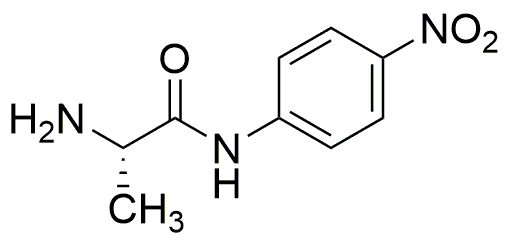L-Alanine 4-nitroanilide is widely utilized in research focused on:
- Biochemical Assays: This compound serves as a substrate in enzyme assays, particularly for detecting the activity of proteases, which are crucial in various biological processes.
- Pharmaceutical Development: It plays a role in drug formulation, especially in the development of new therapeutic agents targeting specific diseases, thanks to its ability to interact with biological molecules.
- Analytical Chemistry: Used in chromatography and spectrophotometry, it helps in the analysis of amino acids and proteins, providing essential data for researchers in biochemistry.
- Material Science: The compound is explored for its potential in creating novel materials with specific properties, aiding in the development of advanced polymers and composites.
- Educational Purposes: It is often used in laboratories for teaching purposes, helping students understand the principles of organic chemistry and enzyme kinetics through hands-on experiments.
General Information
Properties
Safety and Regulations
Applications
L-Alanine 4-nitroanilide is widely utilized in research focused on:
- Biochemical Assays: This compound serves as a substrate in enzyme assays, particularly for detecting the activity of proteases, which are crucial in various biological processes.
- Pharmaceutical Development: It plays a role in drug formulation, especially in the development of new therapeutic agents targeting specific diseases, thanks to its ability to interact with biological molecules.
- Analytical Chemistry: Used in chromatography and spectrophotometry, it helps in the analysis of amino acids and proteins, providing essential data for researchers in biochemistry.
- Material Science: The compound is explored for its potential in creating novel materials with specific properties, aiding in the development of advanced polymers and composites.
- Educational Purposes: It is often used in laboratories for teaching purposes, helping students understand the principles of organic chemistry and enzyme kinetics through hands-on experiments.
Documents
Safety Data Sheets (SDS)
The SDS provides comprehensive safety information on handling, storage, and disposal of the product.
Product Specification (PS)
The PS provides a comprehensive breakdown of the product’s properties, including chemical composition, physical state, purity, and storage requirements. It also details acceptable quality ranges and the product's intended applications.
Certificates of Analysis (COA)
Search for Certificates of Analysis (COA) by entering the products Lot Number. Lot and Batch Numbers can be found on a product’s label following the words ‘Lot’ or ‘Batch’.
*Catalog Number
*Lot Number
Certificates Of Origin (COO)
This COO confirms the country where the product was manufactured, and also details the materials and components used in it and whether it is derived from natural, synthetic, or other specific sources. This certificate may be required for customs, trade, and regulatory compliance.
*Catalog Number
*Lot Number
Safety Data Sheets (SDS)
The SDS provides comprehensive safety information on handling, storage, and disposal of the product.
DownloadProduct Specification (PS)
The PS provides a comprehensive breakdown of the product’s properties, including chemical composition, physical state, purity, and storage requirements. It also details acceptable quality ranges and the product's intended applications.
DownloadCertificates of Analysis (COA)
Search for Certificates of Analysis (COA) by entering the products Lot Number. Lot and Batch Numbers can be found on a product’s label following the words ‘Lot’ or ‘Batch’.
*Catalog Number
*Lot Number
Certificates Of Origin (COO)
This COO confirms the country where the product was manufactured, and also details the materials and components used in it and whether it is derived from natural, synthetic, or other specific sources. This certificate may be required for customs, trade, and regulatory compliance.


